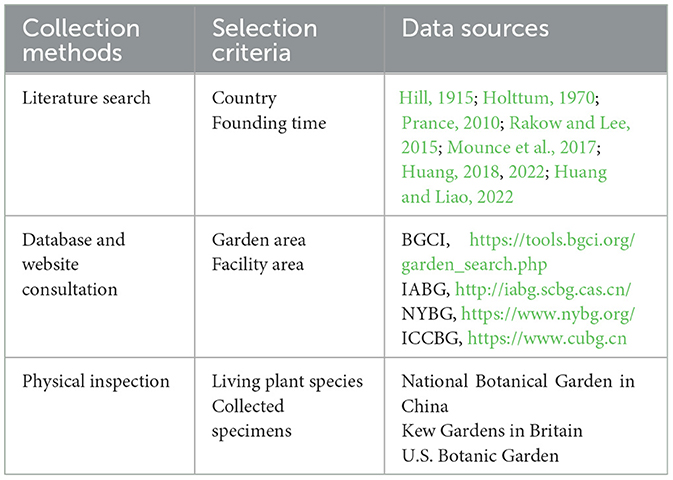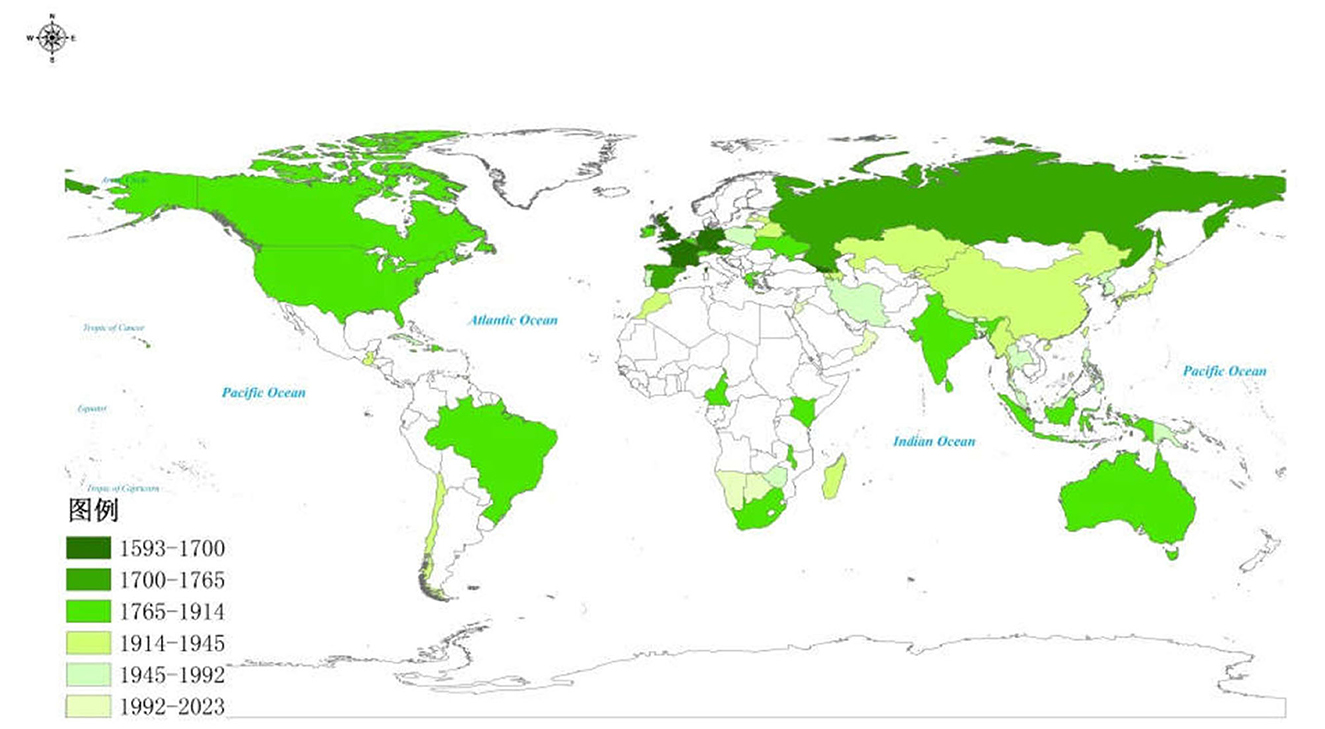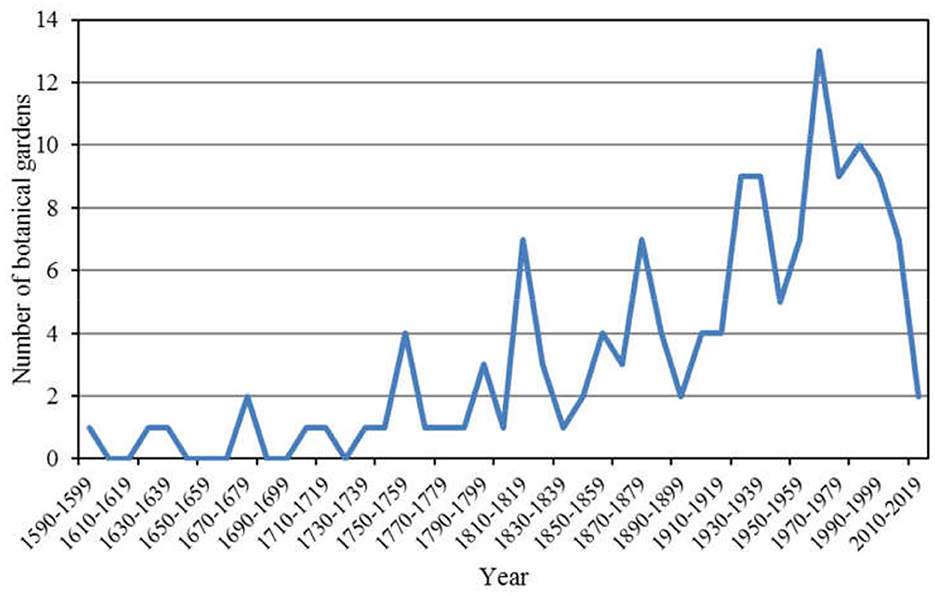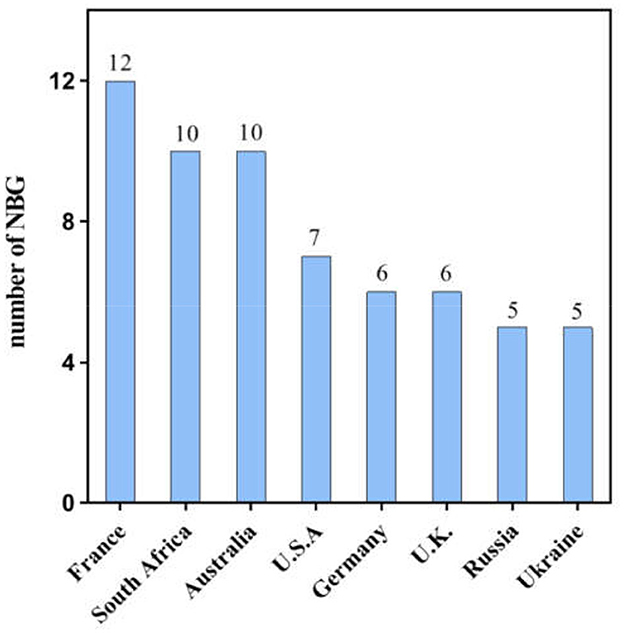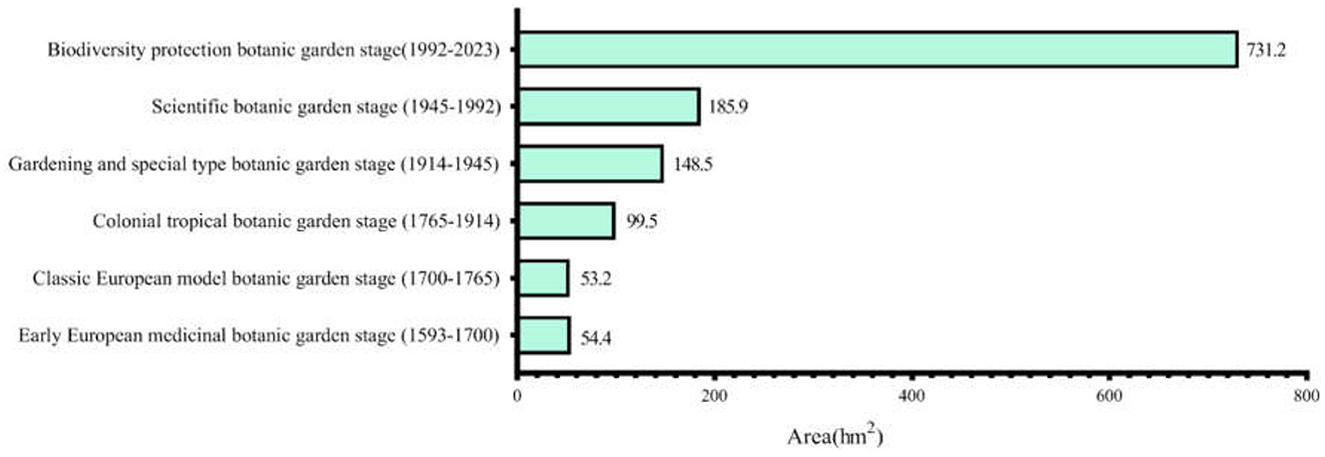- 1School of Life Sciences, Peking University, Beijing, China
- 2Department of Science and Technology, National Forestry and Grassland Administration, Beijing, China
- 3Development Research Center, National Forestry and Grassland Administration, Beijing, China
The national botanic garden is not only a primary means of global ex situ conservation but also a key indicator of biodiversity conservation capacity in a country. To understand the contributions of national botanic gardens from around the world to plant diversity conservation, we generated a long time-series dataset to investigate the spatiotemporal development of national botanic gardens and then explored their functional expansion from 1593 to 2023. The results showed that the development of national botanic gardens was driven by the development demands of human society and could be divided into three stages, i.e., the initial exploration stage of early botanic gardens (1593–1765), the colonial development stage of modern botanic gardens (1765–1945), and the rapid development stage of modern botanic gardens (1945–2023). The first national botanic garden was established in Western Europe, followed by other national botanic gardens being established in the rest of the world. The functions of national botanic gardens evolved from the collection of medicinal and plant resources to multiple purposes, including scientific research, plant diversity conservation, education, and dissemination of knowledge. Contemporary national botanical gardens have played a crucial role in plant diversity conservation and scientific research on the response and adaptation of plant diversity to global change. Future development and management of national botanic gardens will play a crucial role in achieving future targets of the post-2020 global biodiversity framework, which meets the UN Sustainable Development Goals.
1 Introduction
The degradation of terrestrial ecosystems and consequent loss of plant diversity have threatened human wellbeing in the context of global change and will continue to do so (Cardinale et al., 2012; Johnson et al., 2017). Plant diversity is essential to ecosystem function and service delivery, and changes in plant diversity have direct and indirect impacts on ecosystem services, such as ecosystem production, resilience, and processes (Perrings et al., 2010; Arneth et al., 2020). Plant diversity is being lost at an unprecedented rate. Since 1500, global land use has reduced local plant species richness by an average of 13.6% (Newbold et al., 2015). Approximately 21% of seed plants are under threat because of ongoing climate change and increasing anthropocentric disturbances (Duraiappah et al., 2005). Loss of plant diversity leads to the degradation of ecosystem service functions, which, in turn, affects human sustainable development (Mace et al., 2018). The loss of plant diversity and degradation of ecosystems are predicted to further accelerate in the coming years due to further climate changes and the expansion of human land use (Kehoe et al., 2017; Meng et al., 2023). The challenge of conserving, restoring, and sustainably utilizing plant diversity and the urgency to curb plant diversity loss under ongoing climate change and increasing anthropocentric disturbances impel our immediate attention and action (Mace et al., 2018; Geldmann et al., 2019).
In situ conservation and ex situ conservation are two indispensable ways to protect plant diversity. Although national parks and nature reserves secure wildness and provide in situ conservation, plant populations and structures may be vulnerable to anthropocentric disturbances, invasive species, pests, diseases, and climate change (Maxwell et al., 2016; Kremen and Merenlender, 2018). For example, as a common means of in situ conservation, protected areas have been used as a cornerstone for habitat and species conservation (Watson et al., 2014; Gray et al., 2016). Global protected areas have grown rapidly to cover 15.72% of the global land surface in recent decades (Meng et al., 2023). However, human-induced land use and land cover change undermine the spatial distribution and area of global protected areas (Jones et al., 2018; Powers and Jetz, 2019). Global croplands and pastures occupy more than 40% of the land surface (Foley et al., 2005), and this proportion will increase in the future to meet global food demand (Godfray et al., 2010; Potapov et al., 2022). Ex situ conservation under active human management may be a more efficient way to preserve endangered plants and sustain their populations (Ren et al., 2019; Ren and Blackmore, 2023). Ex situ conservation has advantages in conserving plant species with a high risk of endangerment and extinction, and collecting rare and relic plants (Mounce et al., 2017). There are 6,881 tree species collected in ex situ seed banks (O'donnell and Sharrock, 2017), and over 50% of vascular plants are conserved ex situ (Mounce et al., 2017). Ex situ conservation has been defined as an active management action to enable the recovery and conservation of plant species in the 2030 action targets of the post-2020 global biodiversity framework (https://www.cbd.int/conferences/post2020), and the national botanic garden presents a greater possibility in this regard.
To understand the contribution of the national botanic garden to plant diversity conservation, many previous studies have investigated its development and roles. A national botanic garden was originally defined by the International Association of Botanic Gardens (IABG) as a space with open access to the public in which plants are clearly labeled. The definition is then expanded by Botanic Gardens Conservation International (BGCI) and the International Union for Conservation of Nature (IUCN) to a conservation ground for the purposes of scientific research, conservation, education, and display (Westwood et al., 2021). The modern national botanic garden was originally established in Europe in the sixteenth century as a classroom for university students, particularly those studying medicine (Heywood, 2017). Since the eighteenth century, the national botanic garden has begun to use facilities (such as greenhouses) to cultivate plants in similar conditions to those in their natural habitats (Rakow and Lee, 2015). The application of facilities strengthens the ex situ cultivation capacity of the national botanic garden. Benefiting from the strengthened ex situ cultivation capacity, national botanic gardens receive plants from oceanic islands and other countries worldwide (Maunder et al., 2001; Prance, 2010; Zhao et al., 2022). The national botanic garden provides an opportunity to actively conserve and manage a wide range of plant species with high endemism or threatened by habitat destruction and invasion of alien species (Hulbert et al., 2019; Faraji and Karimi, 2022) and has a major function in preventing plant species extinctions (Smith, 2016; Wondafrash et al., 2021). Global national botanic gardens collect 30% of all plant diversity, including up to one-third of the world's flowering plants, and conserve ~13,218 species at risk of extinction covering 41% of the world's known threatened flora (Heywood and Watson, 1995; Engelmann, 2011). The national botanic garden is regarded as an untapped resource for studying the functional ecology of plants (Perez et al., 2019) and acts as a barometer to measure the active management actions of plant diversity conservation in a country (Westwood et al., 2021; Perino et al., 2022). Since the Industrial Revolution, climate change and land cover change have impacted and will continue to impact global ecosystems (Newbold et al., 2015; Meng et al., 2023). National botanic gardens can not only collect and conserve plant diversity but also play a special role in investigating the response and adaptation of plants to climate change (Ali and Trivedi, 2011; Primack et al., 2021). With the development of the national botanic garden, its public roles have expanded to that of cultural institutions for plant species conservation, formal and informal education, scientific research, and popular entertainment (Faraji and Karimi, 2022; Lopez-Villalobos et al., 2022). However, the development stage and plant diversity conservation capacity of national botanic gardens have rarely been explored from a global perspective in previous studies.
To this end, we integrated multisource data from the literature, open databases, and official websites to generate a historical dataset of national botanic gardens to investigate the spatial distribution and temporal change characteristics of national botanic gardens worldwide from 1593 to 2023 and analyze their contribution to plant diversity conservation based on the UN Sustainable Development Goals (UN SDGs). Specifically, we addressed the following questions:
(1) How can the different development stages of global national botanic gardens be distinguished?
(2) What are the contributions of the national botanic gardens to plant diversity conservation?
2 Data and methods
We collected data on national botanic gardens worldwide (including country, founding time, garden area, facility area, living plant species, and collected plant specimens) by applying three methods (Table 1): (1) literature search, (2) consultation of open databases and official websites of world-renowned national botanical gardens, and (3) physical inspection. These data were collected because they could indicate spatial distribution and plant diversity conservation capacity of national botanic gardens. The following selection criteria were applied in the literature search: Country and founding time of the national botanic gardens were presented in the literature; there were garden area and facility (such as greenhouse/glasshouse) area data in the literature; and the living plant species and/or collected plant specimens were either clearly noted or could be directly derived in the literature. We then consulted open databases and the official websites of world-renowned national botanical gardens to collect the same attributes of global national botanic gardens as from the first source (i.e., country, founding time, garden area, facility area, living plant species, and collected plant specimens). The open databases and official websites included those of the Botanic Gardens Conservation International (BGCI), International Association of Botanic Gardens (IABG), New York Botanic Gardens (NYBG), and Initiative for Collective Conservation in Chinese Botanical Gardens (ICCBG). Moreover, we physically inspected the National Botanical Garden in China, Kew Gardens in Britain, and the U.S. Botanic Garden in the United States.
3 Results
3.1 Development stages of national botanic gardens
Since the world's first national botanic garden was established in Germany in 1593, the development of national botanic gardens around the world has had a strong correlation with global social and economic progress. The development of global national botanic gardens can be divided into three major stages (Figure 1): the initial exploration stage of early botanic gardens (1593–1765), the colonial development stage of modern botanic gardens (1765–1945), and the rapid development stage of modern botanic gardens (1945–2023). At present, 68 countries have established 141 national botanic gardens with a total area of 29,000 hm2 and a total number of living plant species of 1.021 million (Figures 1, 2).
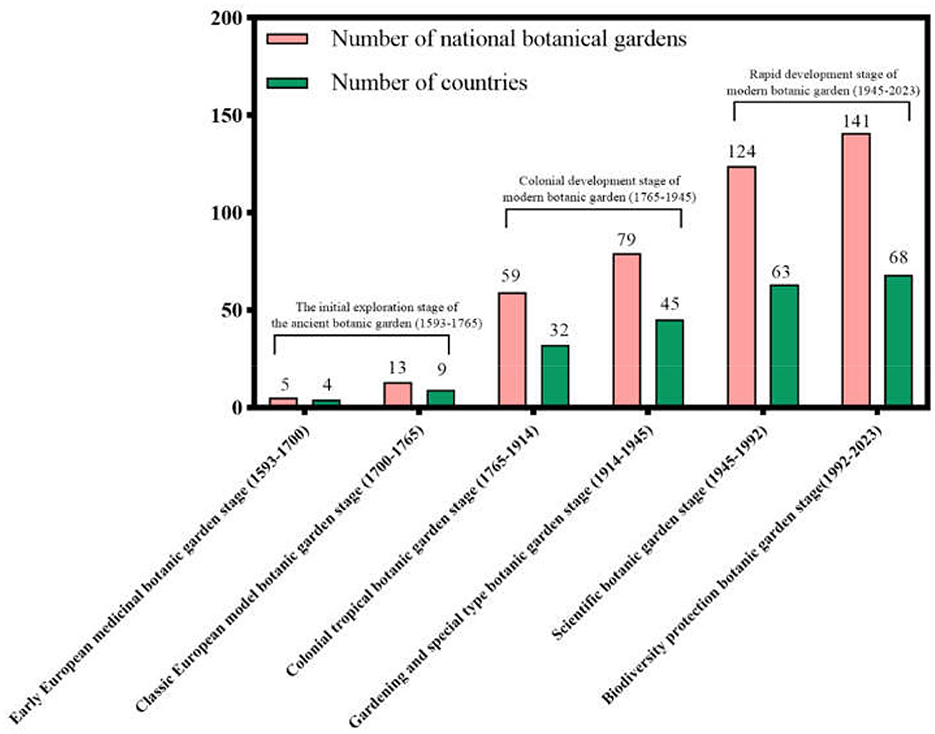
Figure 1. Number of national botanic gardens and countries that have established national botanic gardens at different stages.
3.1.1 Initial exploration stage of early botanic gardens (1593–1765)
The period from the end of the sixteenth century to the middle of the eighteenth century (~170 years) was marked as the beginning of national botanic gardens. During this period, human society was nearing the end of the agricultural civilization, and life's essential needs, such as medicinal materials, were the primary goal of human society in establishing national botanic gardens. During the Renaissance period, the first wave of national botanic gardens emerged in Western Europe in Germany, France, and Britain. Subsequently, national botanic gardens were also created in Russia, Austria, Spain, and other countries. There are two substages in this stage.
(1) Early European medicinal botanic garden stage (1593–1700)
The first substage is the early European medicinal botanic garden stage. During this period, botanic gardens were established to collect medicinal herbs. The Paris Botanical Garden in France was founded in 1626 as the Royal Herb Garden in the time of Louis XIII (1601–1643). The Edinburgh Royal Botanic Garden in England was founded by two doctors (Dr. Robert Sibbald and Dr. Andrew Balfour) in 1670, and only medicinal plants were planted. Then, the Berlin-Dahlem Botanic Garden in Germany was founded in 1679 and served as a royal kitchen and herbal botanical garden.
(2) Classic European model botanic garden stage (1700–1765)
In the eighteenth century, the development of national botanic gardens followed the classic European model of botanic gardens. Swedish biologist Carl von Linné (1707–1778) created a binary nomenclature for plant taxonomy, enhancing the efficiency of categorizing plant species in national botanic gardens. During this period, Britain, Russia, Austria, Spain, and Malta, established national botanic gardens, with other European countries establishing seven further national botanic gardens, while in Mauritius in Africa, a national botanic garden was also established. The total number of national botanic gardens established in nine countries around the world increased to 13. Kew Gardens, a world-famous national botanical garden, was established in 1759 and was defined as a comprehensive botanical garden centered around taxonomic research. The Kew Gardens has collected and introduced more than 80,000 plant species, covering one-sixth of the higher plants in the world, and was listed in the World Heritage List in 2003.
3.1.2 Colonial development stage of modern botanic gardens (1765–1945)
The second stage is the colonial development stage of modern botanic gardens, which extended from Europe's Industrial Revolution in 1765 to the end of the Second World War in 1945. During the 180 years, 36 countries established 66 new national botanic gardens. The total number of global national botanic gardens increased to 79, which were established in 45 countries. There are two substages in this stage.
(1) Colonial tropical botanic garden stage (1765–1914)
During 1765–1914, the advancement of the Industrial Revolution and the implementation of European colonial policy resulted in the expansion of national botanic gardens from Europe to colonial countries and regions worldwide, which furthered the establishment of national botanic gardens worldwide. During this period, national botanic gardens were established in the following tropical countries: Asian countries such as India, Indonesia, Sri Lanka, and Singapore; African countries such as South Africa, Cameroon, Kenya, Malawi, and Seychelles; countries in the Americas such as Brazil, Jamaica, Dominica, Grenada, the United States, and Canada; and Australia in Oceania. Plant hunters collected and introduced a great number of native plants from these countries to Europe. Greenhouses were established and enabled the cultivation of non-native plants such as tropical plants in European national botanic gardens. The greenhouse gradually became the standard facility used in large national botanic gardens. Before the First World War in 1914, there were at least 59 national botanic gardens in 32 countries on five continents.
(2) Gardening and specialized botanic garden stage (1914–1945)
In the first half of the twentieth century, social and economic development worldwide brought about the demand for horticulture and landscape gardens. Gardening and related specialized botanic gardens started to rapidly emerge and replace the colonial tropical botanic gardens. In Europe (Latvia, Belarus, and Monaco), Asia (Myanmar, Japan, China, Armenia, Azerbaijan, Kazakhstan, and Kyrgyzstan), Africa (Madagascar), and the Americas (Chile and Guatemala), 20 new national botanic gardens were established, and the total number of global national botanic gardens increased to 79 in 45 countries.
3.1.3 Rapid development stage of modern botanic gardens (1945–2023)
Since the end of the Second World War in 1945, human society has entered a period of peace and development, and the development of the national botanic garden entered the rapid development stage of modern botanic gardens. A great number of modern national botanic gardens were established. During this period, 62 new national botanic gardens were established with an increasing rate of 0.8 gardens per year, which is 10 times more than that in the first stage (0.08 gardens per year) and 2.2 times more than that in the second stage (0.37 gardens per year). There are two substages in this stage.
(1) Scientific botanic gardens stage (1945–1992)
After the end of the Second World War, national botanic gardens shifted their focus to scientific research, aligning with the significant progress in science and technology. Between 1945 and 1992, 45 national botanic gardens were established among the following countries: Portugal and Poland (Europe); North Korea, the Philippines, Nepal, Iran, Thailand, South Korea, Bangladesh, and Malaysia (Asia); Zimbabwe and Cape Verde (Africa); Cuba, Antigua and Barbuda, Belize, and Dominica (the Americas); and Papua New Guinea (Oceania). The total number of national botanic gardens worldwide increased to 124.
(2) Biodiversity conservation botanic gardens stage (1992–2023)
In 1992, the United Nations Convention on Biological Diversity was signed during the United Nations Conference on Environment and Development. This agreement marked human societies' recognition that biodiversity is the basis for human survival and development. The sustainable use of biological resources as one of the most important global targets was confirmed, and this confirmation shifted the function of global national botanic gardens to biodiversity conservation. From 1992 to 2023, 17 new national botanic gardens were established. The total number of global national botanic gardens increased to 141 in 68 countries on five continents. However, there were still many countries without national botanic gardens in Africa and South America (Figure 2), although these areas had abundant plant species.
3.2 Spatiotemporal changes in national botanic gardens
3.2.1 Temporal change in national botanic gardens
Figure 3 shows the number of newly established national botanic gardens in each decade. Before 1750, only one new botanic garden was established each decade. From 1750 to the early twentieth century, the increasing rate reached four gardens per decade. From the early twentieth century to the present, this rate increased to eight gardens per decade. The peak increasing rates were found in the 1810s, 1870s, 1920–1930s, 1960s, and 1980s.
3.2.2 Distribution of national botanic gardens
Figure 4 shows that national botanic gardens are mainly distributed in Eurasia, followed by Americas, Africa, and Oceania. Europe and Asia are the leaders in establishing national botanic gardens. The total number of national botanic gardens is 49 and 35 in Europe and Asia, respectively, which were established in 17 and 23 countries, respectively. Figure 5 shows that the leading country with the highest number of national botanic gardens is France (number of national botanic gardens: 12), followed by South Africa (10), Australia (10), the United States (7), Germany (6), the United Kingdom (6), Russia (5), and Ukraine (5).
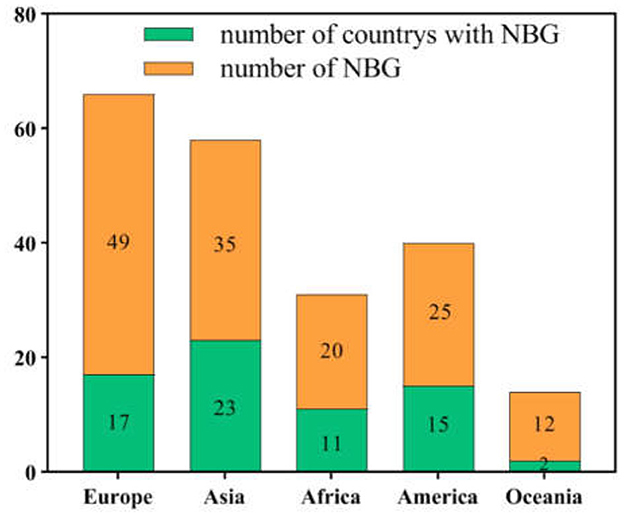
Figure 4. Number of national botanic gardens worldwide and number of countries with national botanic gardens on each continent.
3.3 Characteristics of national botanic gardens
3.3.1 Area and facilities of national botanic gardens
Figure 6A shows that 37% of national botanic gardens are medium-sized gardens with an area of 10–50 hm2, and 19% are larger-scale gardens with an area of 101–200 hm2. Large gardens with an area over 500 hm2 are the fewest in number. The largest garden is the South African National Biodiversity Institute. The greenhouse is the common facility or infrastructure in national botanic gardens, which has strengthened the cultivating capacity of these gardens and allowed them to receive non-native plants from other areas all over the world. Using greenhouse area data from 38% of national botanical gardens, we found that 18% of global national botanic gardens built medium-sized greenhouses with areas between 1,000 and 4,999 m2, and few national botanic gardens built large greenhouses with areas over 20,000 m2 (Figure 6B).
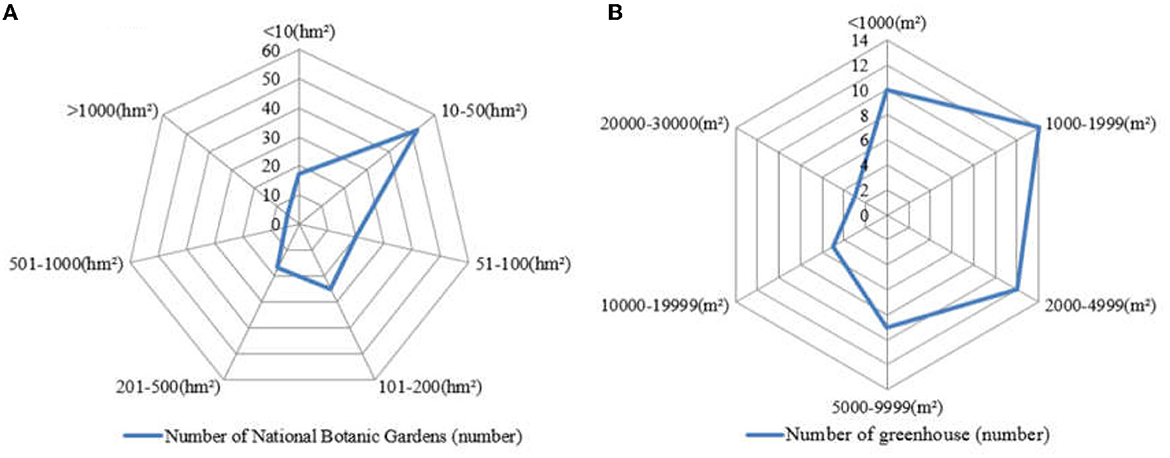
Figure 6. Number of national botanic gardens with different areas (A) and different greenhouse areas (B).
The average areas of national botanic gardens at different development stages showed an increasing trend (Figure 7). In the early European medicinal and classic European model botanic garden stages during 1593–1765, the average area of national botanic gardens was ~50 hm2. In the colonial tropical botanic garden stage during 1765–1914, the average area of national botanic gardens gradually increased to nearly 100 hm2. In the horticulture, specialized, and scientific botanic garden stages during 1914–1992, the average area of national botanic gardens exceeded 100 hm2. In the biodiversity conservation botanic garden stage after 1992, the average area of national botanic gardens soared to 731.2 hm2.
3.3.2 Plant diversity conservation in national botanic gardens
Figure 8A shows that more than 35% of national botanic gardens have 1,000–4,999 living plant species, followed by those with 5,000–9,999, 10,000–49,999, and fewer than 1,000 living plant species at 23, 21, and 18%, respectively. National botanic gardens with over 50,000 living plant species are rare, at only 3%. Using plant specimen data from 40% of national botanical gardens, we found that 16% of national botanic gardens collect fewer than 100,000 plant specimens, followed by those collecting 1,000,000–4,990,000, 100,000–490,000, and 500,000–990,000 plant specimens, representing 9, 7, and 6%, respectively. Only 3% of national botanic gardens collect over 5,000,000 specimens (Figure 8B).

Figure 8. Percentages of national botanic gardens with different numbers of living plant species (A) and collected plant specimens (×104) (B).
The average number of living plant species in national botanic gardens worldwide at different development stages showed a decreasing trend (Figure 9). In the early European medicinal and classic European model botanic garden stages, the average numbers of living plant species in national botanic gardens were 14,800 and 13,250, respectively. In the colonial tropical botanic garden and horticulture and specialized botanic garden stages, the numbers decreased to 8,744 and 8,957, respectively. In the scientific botanic garden stage, the number decreased to 5,013. In the biodiversity conservation botanic garden stage after 1992, the number slumped to 2,021.

Figure 9. Average number of living plant species in national botanic gardens at different development stages.
4 Discussion
4.1 Different national botanic garden development stages driven by different purposes
In this study, we investigated the spatiotemporal development of global national botanic gardens. The development stages were driven by different concepts or purposes. In the initial exploration stage (1593–1765), national botanic gardens originated from medicinal gardens during the European Renaissance period. National botanic gardens were established in the form of herb gardens to meet the medical needs of European royals and were then facilitated by the development of botany and university botanists (Maunder et al., 2001; Rakow and Lee, 2015). From the sixteenth to eighteenth centuries, with the Enlightenment and the development of natural sciences, a large number of scientific research-oriented botanic gardens were established in Europe, promoting the scientific development of botany (Hill, 1915).
In the colonial stage of the modern national botanic garden (1765–1945), national botanic gardens significantly expanded from Europe to Asia, Americas, Africa, and Oceania. The expansion of the national botanic garden in this stage was accompanied by the expansion of European colonization (Baber, 2016), as well as growing social demand for horticulture and landscape architecture in the first half of the twentieth century (Swarts and Dixon, 2009; Krishnan and Novy, 2016). Depending on the characteristics of the collected living plants, national botanic gardens played a mainstream role in research on plant taxonomy and plant systematics. At this stage, Africa and South America provided a great number of native plants to European national botanic gardens and promoted their rapid development (Chen et al., 2009). However, Africa and South America currently have few national botanic gardens. During the colonial era, national botanic gardens were mainly established as a consequence of trade and commerce (Faraji and Karimi, 2022). European national botanic gardens, such as the Kew Botanical Garden, cultivate economically useful plants and trade with countries on other continents (Hu, 2005; Prance, 2010; Ali and Trivedi, 2011). The commercial purpose limited the expansion of national botanic gardens in Africa and South America, which were plant resource suppliers.
In the modern stage of national botanic gardens (1945–2023), nature and biodiversity protection, underpinned by scientific progress and growing environmental concerns, promoted the establishment of national botanic gardens worldwide (Cannon and Kua, 2017; Philpott et al., 2022). Since the twentieth century, especially since the mid to late twentieth century, the degradation of ecosystems and loss of plant diversity have received much attention under ongoing climate change and increasing anthropocentric disturbance, and the goals of national botanic gardens have been focused on plant diversity conservation, education, public display, and knowledge dissemination (Donaldson, 2009; Cannon and Kua, 2017). The purposes of establishing national botanic gardens have shifted from meeting human needs (e.g., medical herb cultivation, scientific research, and landscape appreciation) to nature conservation (Krishnan and Novy, 2016). Such changes reflect the changing relationship between human society and natural ecosystems, which was driven by the shift from the dominance of anthropocentrism to the boom of biocentrism and ecocentrism (Gao et al., 2018).
4.2 Collaborative action of national botanic gardens
Along with the expansion of national botanic gardens from Europe to the rest of the world, the average area of national botanic gardens showed an increasing trend, but the average number of plant species in these gardens showed a decreasing trend. On the one hand, this contrast was caused by the weaker collecting capacity of newly established national botanic gardens. Newly established or forthcoming national botanic gardens should thus prioritize the curation of their plant species collections. On the other hand, endangered or rare plant species cultivated in old national botanic gardens in Europe may be introduced to newly established national botanic gardens through collaborative research and programs (Aronson and ERA of Botanic Gardens, 2014). This may not only help enrich the attraction of the new botanic gardens but also contribute to the conservation of biodiversity through global efforts.
Countries around the world have successively passed legislation to protect rare, endemic, threatened, and endangered species. At the International Botanic Gardens Conference held in Spain in 1985, with the theme of Botanic Gardens and the World Conservation Strategy, a consensus was reached on the protection of plant diversity, which called for global national botanic gardens to unite and use in situ and ex situ methods to save the rapidly disappearing global plant diversity (Wyse Jackson and Sutherland, 2000; Wyse Jackson and Kennedy, 2009). In 2022, the approval of the Global Strategy for Plant Conservation (GSPC) ushered in a new era of global national botanic gardens committed to protecting plant diversity in the twenty-first century (Philpott et al., 2022; Zhao et al., 2022).
4.3 Contribution of national botanic gardens to global biodiversity conservation
The goal of establishing national botanic gardens expanded from the original purpose of introducing medicinal plants to multiple purposes of scientific research, education, and other recreational values (Primack et al., 2021). Among these purposes, botanic gardens play leading roles in plant taxonomy, systematics, and horticulture (Donaldson, 2009), providing the opportunity to conserve plant diversity ex situ and prevent species extinction (Oldfield, 2009). To conserve rare, threatened, and endangered plant species, greenhouses and other facilities have been built in national botanic gardens to cultivate plant species in conditions similar to those in their natural habitats (Maunder et al., 2001; Pritchard et al., 2012) and provide a platform for scientific research on non-native plants neglecting limitations of plant growth time and distribution (Engelmann, 2011; Primack et al., 2021; Wondafrash et al., 2021). To meet the requirements of biodiversity conservation, seed banks and germplasm resources are being included in the plans of national botanic gardens (O'donnell and Sharrock, 2017). In addition, scientific research based on gardens and environmental education programs is extensively carried out to utilize knowledge for plant diversity conservation and increase public knowledge (Baber, 2016). Currently, national botanic gardens are an indispensable part of urban green areas that deliver regulative and cultural services (Heywood, 2017). The important role of national botanic gardens in scientific research, plant diversity conservation, and education will be stronger in the future (Cannon and Kua, 2017).
National botanic gardens play an important role in plant biodiversity conservation through living plant and seed bank collections, and deliver ecosystem services for the wellbeing of society. The ecosystem services of national botanic gardens are aligned with the UN SDGs. The primary roles of national botanic gardens are intimately associated with the SDGs that are related to plant conservation, climate action, public education, and sustainable development (Lopez-Villalobos et al., 2022). Life on land (SDG 15) is the most relevant goal linking the conservation role of national botanic gardens. SDG 15 concerns protecting, restoring, and promoting the sustainable use of terrestrial ecosystems, sustainably managing forests, combating desertification, halting and reversing land degradation, and halting biodiversity loss. National botanic gardens possess abundant living plant collections, seed banks, or germplasm resources that provide a great platform to conserve rare, threatened, and endangered plant species and to study their response and adaptation to global change (Johnson et al., 2017). In addition, sustainability education aligned with the UN SDGs provides botanic gardens a rich platform to showcase their expertise in horticulture, plant science, and public awareness of plant diversity (Lopez-Villalobos et al., 2022; Ren and Blackmore, 2023). National botanic gardens also provide expertise and disseminate knowledge on the ex situ protection and scientific research of plants (Dunn, 2017). The disseminated activities include science popularization exhibitions, live lectures, and online science popularization about the roles of national botanic gardens in plant biodiversity conservation and climate mitigation, which are highly accepted by the public (Lopez-Villalobos et al., 2022).
It should be pointed out that the risk of plant invasion should not be underestimated during the management of national botanic gardens. Non-native plant species have been introduced to national botanic gardens for acclimatization, stimulation of local horticulture, or commercial purposes (Heywood, 2011; Hulme, 2011). However, ~37% of previous studies about invasive plant species originated from protected areas (Foxcroft et al., 2017). Assessing the invasion risk of living plant species will advance risk management of national botanic gardens.
5 Conclusion
In this study, we generated long-term historical data on global national botanic gardens to investigate the development of the national botanic garden and explored its contributions to plant diversity conservation from 1593 to 2023. We found that the development of national botanic gardens worldwide was driven by the basic needs of human society. National botanical gardens were initially developed in the sixteenth century for the purpose of collecting medicinal plants and then expanded to Asia, Americas, and Africa for the purposes of trade and commerce in the seventeenth and nineteenth centuries. After the twentieth century, national botanic gardens were established to achieve the multiple purposes of scientific research, plant diversity conservation, education, and public dissemination of knowledge. Global national botanic gardens have not only played and will continue to play an important role in conserving rare, threatened, and endangered plant species but can also attract public attention to the global biodiversity framework. Newly established national botanic gardens can collect rare plant species through collaborative research and programs to achieve this role. The findings of this study can improve our understanding of the role of national botanic gardens in plant diversity conservation from a global perspective and help decision-makers advance the development of national botanic gardens.
Data availability statement
The raw data supporting the conclusions of this article will be made available by the authors, without undue reservation.
Author contributions
YL: Data curation, Formal analysis, Writing – original draft. SL: Conceptualization, Methodology, Supervision, Writing – review & editing. GZ: Conceptualization, Funding acquisition, Methodology, Writing – review & editing.
Funding
The author(s) declare financial support was received for the research, authorship, and/or publication of this article. This research was funded by the National Social Science Fund of China (Grant Number 22BGL017).
Conflict of interest
The authors declare that the research was conducted in the absence of any commercial or financial relationships that could be construed as a potential conflict of interest.
Publisher's note
All claims expressed in this article are solely those of the authors and do not necessarily represent those of their affiliated organizations, or those of the publisher, the editors and the reviewers. Any product that may be evaluated in this article, or claim that may be made by its manufacturer, is not guaranteed or endorsed by the publisher.
References
Ali, N. S., and Trivedi, C. (2011). Botanic gardens and climate change: a review of scientific activities at the Royal Botanic Gardens, Kew. Biodiver. Conserv. 20, 295–307. doi: 10.1007/s10531-010-9944-4
Arneth, A., Shin, Y.-J., Leadley, P., Rondinini, C., Bukvareva, E., Kolb, M., et al. (2020). Post-2020 biodiversity targets need to embrace climate change. Proc. Natl. Acad. Sci. 117, 30882–30891. doi: 10.1073/pnas.2009584117
Aronson J. ERA of Botanic Gardens (2014). The ecological restoration alliance of botanic gardens: a new initiative takes root. Restor. Ecol. 22, 713–715. doi: 10.1111/rec.12151
Baber, Z. (2016). The plants of empire: botanic gardens, colonial power and botanical knowledge. J. Contemp. Asia 46, 659–679. doi: 10.1080/00472336.2016.1185796
Cannon, C. H., and Kua, C.-S. (2017). Botanic gardens should lead the way to create a “Garden Earth” in the anthropocene. Plant Diver. 39, 331–337. doi: 10.1016/j.pld.2017.11.003
Cardinale, B. J., Duffy, J. E., Gonzalez, A., Hooper, D. U., Perrings, C., Venail, P., et al. (2012). Biodiversity loss and its impact on humanity. Nature 486, 59–67. doi: 10.1038/nature11148
Chen, J., Cannon, C. H., and Hu, H. (2009). Tropical botanical gardens: at the in situ ecosystem management frontier. Trends Plant Sci. 14, 584–589. doi: 10.1016/j.tplants.2009.08.010
Donaldson, J. S. (2009). Botanic gardens science for conservation and global change. Trends Plant Sci. 14, 608–613. doi: 10.1016/j.tplants.2009.08.008
Dunn, C. P. (2017). Biological and cultural diversity in the context of botanic garden conservation strategies. Plant Diver. 39, 396–401. doi: 10.1016/j.pld.2017.10.003
Duraiappah, A. K., Naeem, S., Agardy, T., Ash, N. J., Cooper, D., Díaz, S., et al. (2005). Ecosystems and Human Well-Being: Biodiversity Synthesis. Washington, DC: Island Press.
Engelmann, F. (2011). Use of biotechnologies for the conservation of plant biodiversity. In Vitro Cell. Dev. Biol. Plant 47, 5–16. doi: 10.1007/s11627-010-9327-2
Faraji, L., and Karimi, M. (2022). Botanical gardens as valuable resources in plant sciences. Biodiv. Conserv. 31, 2905–2926. doi: 10.1007/s10531-019-01926-1
Foley, J. A., Defries, R., Asner, G. P., Barford, C., Bonan, G., Carpenter, S. R., et al. (2005). Global consequences of land use. Science 309, 570–574. doi: 10.1126/science.1111772
Foxcroft, L. C., Pyšek, P., Richardson, D. M., Genovesi, P., and Macfadyen, S. (2017). Plant invasion science in protected areas: progress and priorities. Biol. Invasions 19, 1353–1378. doi: 10.1007/s10530-016-1367-z
Gao, J., Zhang, C., and Huang, Z. (2018). Chinese tourists' views of nature and natural landscape interpretation: a generational perspective. J. Sustain. Tour. 26, 668–684. doi: 10.1080/09669582.2017.1377722
Geldmann, J., Manica, A., Burgess, N. D., Coad, L., and Balmford, A. (2019). A global-level assessment of the effectiveness of protected areas at resisting anthropogenic pressures. Proc. Natl. Acad. Sci. 116, 23209–23215. doi: 10.1073/pnas.1908221116
Godfray, H. C. J., Beddington, J. R., Crute, I. R., Haddad, L., Lawrence, D., Muir, J. F., et al. (2010). Food security: the challenge of feeding 9 billion people. Science 327, 812–818. doi: 10.1126/science.1185383
Gray, C. L., Hill, S. L. L., Newbold, T., Hudson, L. N., Börger, L., Contu, S., et al. (2016). Local biodiversity is higher inside than outside terrestrial protected areas worldwide. Nature Commun. 7, 12306. doi: 10.1038/ncomms12306
Heywood, V. H. (2011). The role of botanic gardens as resource and introduction centres in the face of global change. Biodiv. Conserv. 20, 221–239. doi: 10.1007/s10531-010-9781-5
Heywood, V. H. (2017). The future of plant conservation and the role of botanic gardens. Plant Divers 39, 309–313. doi: 10.1016/j.pld.2017.12.002
Heywood, V. H., and Watson, R. T. (1995). Global Biodiversity Assessment. Cambridge: Cambridge University Press.
Hill, A. W. (1915). The history and functions of botanic gardens. Ann. Missouri Botanical Garden 2, 185–240. doi: 10.2307/2990033
Holttum, R. E. (1970). The historical significance of botanic gardens in S.E. Asia. TAXON 19, 707–714. doi: 10.2307/1219283
Hu, Y. (2005). New development of botanic gardens in the new century. Chin. Landscape Archit. 21, 12–18. doi: 10.3969/j.issn.1000-6664.2005.10.003
Huang, H. (2018). “Science, art and responsibility”: the scientific and social function changes of a 500-year history of botanical gardens. II. Intension of sciences. Biodiv. Sci. 26, 304–314. doi: 10.17520/biods.2017331
Huang, H., and Liao, J. (2022). On China's national botanical gardens: building a comprehensive system of ex situ conservation of national botanical gardens with task oriented disciplines. Biodiv. Sci. 30, 22220. doi: 10.17520/biods.2022220
Hulbert, J. M., Paap, T., Burgess, T. I., Roets, F., and Wingfield, M. J. (2019). Botanical gardens provide valuable baseline Phytophthora diversity data. Urban Forest. Urban Green. 46, 126461. doi: 10.1016/j.ufug.2019.126461
Hulme, P. E. (2011). Addressing the threat to biodiversity from botanic gardens. Trends Ecol. Evol. 26, 168–174. doi: 10.1016/j.tree.2011.01.005
Johnson, C. N., Balmford, A., Brook, B. W., Buettel, J. C., Galetti, M., Guangchun, L., et al. (2017). Biodiversity losses and conservation responses in the Anthropocene. Science 356, 270–275. doi: 10.1126/science.aam9317
Jones, K. R., Venter, O., Fuller, R. A., Allan, J. R., Maxwell, S. L., Negret, P. J., et al. (2018). One-third of global protected land is under intense human pressure. Science 360, 788–791. doi: 10.1126/science.aap9565
Kehoe, L., Romero-Muñoz, A., Polaina, E., Estes, L., Kreft, H., and Kuemmerle, T. (2017). Biodiversity at risk under future cropland expansion and intensification. Nat. Ecol. Evol. 1, 1129–1135. doi: 10.1038/s41559-017-0234-3
Kremen, C., and Merenlender, A. M. (2018). Landscapes that work for biodiversity and people. Science 362, eaau6020. doi: 10.1126/science.aau6020
Krishnan, S., and Novy, A. (2016). The role of botanic gardens in the twenty-first century. CABI Rev. 11, 1–9. doi: 10.1079/PAVSNNR201611023
Lopez-Villalobos, A., Bunsha, D., Austin, D., Caddy, L., Douglas, J., Hill, A., et al. (2022). Aligning to the UN sustainable development goals: assessing contributions of UBC botanical garden. Sustainability 14, 6275. doi: 10.3390/su14106275
Mace, G. M., Barrett, M., Burgess, N. D., Cornell, S. E., Freeman, R., Grooten, M., et al. (2018). Aiming higher to bend the curve of biodiversity loss. Nat. Sustain. 1, 448–451. doi: 10.1038/s41893-018-0130-0
Maunder, M., Higgens, S., and Culham, A. (2001). The effectiveness of botanic garden collections in supporting plant conservation: a European case study. Biodiv. Conserv. 10, 383–401. doi: 10.1023/A:1016666526878
Maxwell, S. L., Fuller, R. A., Brooks, T. M., and Watson, J. E. M. (2016). Biodiversity: the ravages of guns, nets and bulldozers. Nature 536, 143–145. doi: 10.1038/536143a
Meng, Z., Dong, J., Ellis, E. C., Metternicht, G., Qin, Y., Song, X.-P., et al. (2023). Post-2020 biodiversity framework challenged by cropland expansion in protected areas. Nat. Sustain. 6, 758–768. doi: 10.1038/s41893-023-01093-w
Mounce, R., Smith, P., and Brockington, S. (2017). Ex situ conservation of plant diversity in the world's botanic gardens. Nat. Plants 3, 795–802. doi: 10.1038/s41477-017-0019-3
Newbold, T., Hudson, L. N., Hill, S. L. L., Contu, S., Lysenko, I., Senior, R. A., et al. (2015). Global effects of land use on local terrestrial biodiversity. Nature 520, 45–50. doi: 10.1038/nature14324
O'donnell, K., and Sharrock, S. (2017). The contribution of botanic gardens to ex situ conservation through seed banking. Plant Diver. 39, 373–378. doi: 10.1016/j.pld.2017.11.005
Oldfield, S. F. (2009). Botanic gardens and the conservation of tree species. Trends Plant Sci. 14, 581–583. doi: 10.1016/j.tplants.2009.08.013
Perez, T. M., Valverde-Barrantes, O., Bravo, C., Taylor, T. C., Fadrique, B., Hogan, J. A., et al. (2019). Botanic gardens are an untapped resource for studying the functional ecology of tropical plants. Philos. Trans. R. Soc. B Biol. Sci. 374, 20170390. doi: 10.1098/rstb.2017.0390
Perino, A., Pereira, H. M., Felipe-Lucia, M., Kim, H., Kühl, H. S., Marselle, M. R., et al. (2022). Biodiversity post-2020: Closing the gap between global targets and national-level implementation. Conserv. Lett. 15, e12848. doi: 10.1111/conl.12848
Perrings, C., Naeem, S., Ahrestani, F., Bunker, D. E., Burkill, P., Canziani, G., et al. (2010). Ecosystem services for 2020. Science 330, 323–324. doi: 10.1126/science.1196431
Philpott, M., Pence, V. C., Bassüner, B., Clayton, A. S., Coffey, E. E. D., Downing, J. L., et al. (2022). Harnessing the power of botanical gardens: evaluating the costs and resources needed for exceptional plant conservation. Appl. Plant Sci. 10, e11495. doi: 10.1002/aps3.11495
Potapov, P., Turubanova, S., Hansen, M. C., Tyukavina, A., Zalles, V., Khan, A., et al. (2022). Global maps of cropland extent and change show accelerated cropland expansion in the twenty-first century. Nat. Food 3, 19–28. doi: 10.1038/s43016-021-00429-z
Powers, R. P., and Jetz, W. (2019). Global habitat loss and extinction risk of terrestrial vertebrates under future land-use-change scenarios. Nat. Clim. Change 9, 323–329. doi: 10.1038/s41558-019-0406-z
Prance, G. T. (2010). A brief history of conservation at the Royal Botanic Gardens, Kew. Kew Bull. 65, 501–508. doi: 10.1007/s12225-010-9231-2
Primack, R. B., Ellwood, E. R., Gallinat, A. S., and Miller-Rushing, A. J. (2021). The growing and vital role of botanical gardens in climate change research. New Phytol. 231, 917–932. doi: 10.1111/nph.17410
Pritchard, D. J., Fa, J. E., Oldfield, S., and Harrop, S. R. (2012). Bring the captive closer to the wild: redefining the role of ex situ conservation. Oryx 46, 18–23. doi: 10.1017/S0030605310001766
Rakow, D. A., and Lee, S. A. (2015). Western botanical gardens: history and evolution. Horticul. Rev. 43, 269–310. doi: 10.1002/9781119107781.ch05
Ren, H., and Blackmore, S. (2023). The role of National Botanical Gardens to benefit sustainable development. Trends Plant Sci. 28, 731–733. doi: 10.1016/j.tplants.2023.04.009
Ren, H., Qin, H., Ouyang, Z., Wen, X., Jin, X., Liu, H., et al. (2019). Progress of implementation on the Global Strategy for Plant Conservation in (2011–2020) China. Biol. Conserv. 230, 169–178. doi: 10.1016/j.biocon.2018.12.030
Smith, P. (2016). Building a global system for the conservation of all plant diversity: a vision for botanic gardens and botanic gardens conservation international. Sibbaldia Int. J. Botan. Garden Horticult. 14, 5–13. doi: 10.24823/Sibbaldia.2016.208
Swarts, N. D., and Dixon, K. W. (2009). Perspectives on orchid conservation in botanic gardens. Trends Plant Sci. 14, 590–598. doi: 10.1016/j.tplants.2009.07.008
Watson, J. E. M., Dudley, N., Segan, D. B., and Hockings, M. (2014). The performance and potential of protected areas. Nature 515, 67–73. doi: 10.1038/nature13947
Westwood, M., Cavender, N., Meyer, A., and Smith, P. (2021). Botanic garden solutions to the plant extinction crisis. Plants People Planet 3, 22–32. doi: 10.1002/ppp3.10134
Wondafrash, M., Wingfield, M. J., Wilson, J. R. U., Hurley, B. P., Slippers, B., and Paap, T. (2021). Botanical gardens as key resources and hazards for biosecurity. Biodiv. Conserv. 30, 1929–1946. doi: 10.1007/s10531-021-02180-0
Wyse Jackson, P., and Kennedy, K. (2009). The Global Strategy for Plant Conservation: a challenge and opportunity for the international community. Trends Plant Sci. 14, 578–580. doi: 10.1016/j.tplants.2009.08.011
Wyse Jackson, P., and Sutherland, L. (2000). International Agenda for Botanic Gardens in Conservation. London: Botanic Gardens Conservation International.
Keywords: national botanic garden, global change, ex situ plant diversity conservation, forest management, post-2020 global biodiversity framework
Citation: Li Y, Li S and Zhao G (2023) Spatiotemporal development of national botanic gardens worldwide and their contributions to plant diversity conservation from 1593 to 2023. Front. For. Glob. Change 6:1310381. doi: 10.3389/ffgc.2023.1310381
Received: 09 October 2023; Accepted: 24 November 2023;
Published: 14 December 2023.
Edited by:
Jian Tao, Shandong Institute of Business and Technology, ChinaReviewed by:
Wenbin Liu, Chinese Academy of Sciences (CAS), ChinaNan Cong, Chinese Academy of Sciences (CAS), China
Copyright © 2023 Li, Li and Zhao. This is an open-access article distributed under the terms of the Creative Commons Attribution License (CC BY). The use, distribution or reproduction in other forums is permitted, provided the original author(s) and the copyright owner(s) are credited and that the original publication in this journal is cited, in accordance with accepted academic practice. No use, distribution or reproduction is permitted which does not comply with these terms.
*Correspondence: Shidong Li, ZWFzdHdvcmxkQHNvaHUuY29t; Guangshuai Zhao, emhhb2dzLjEwc0BpZ3NucnIuYWMuY24=
 Yiyi Li1
Yiyi Li1 Guangshuai Zhao
Guangshuai Zhao